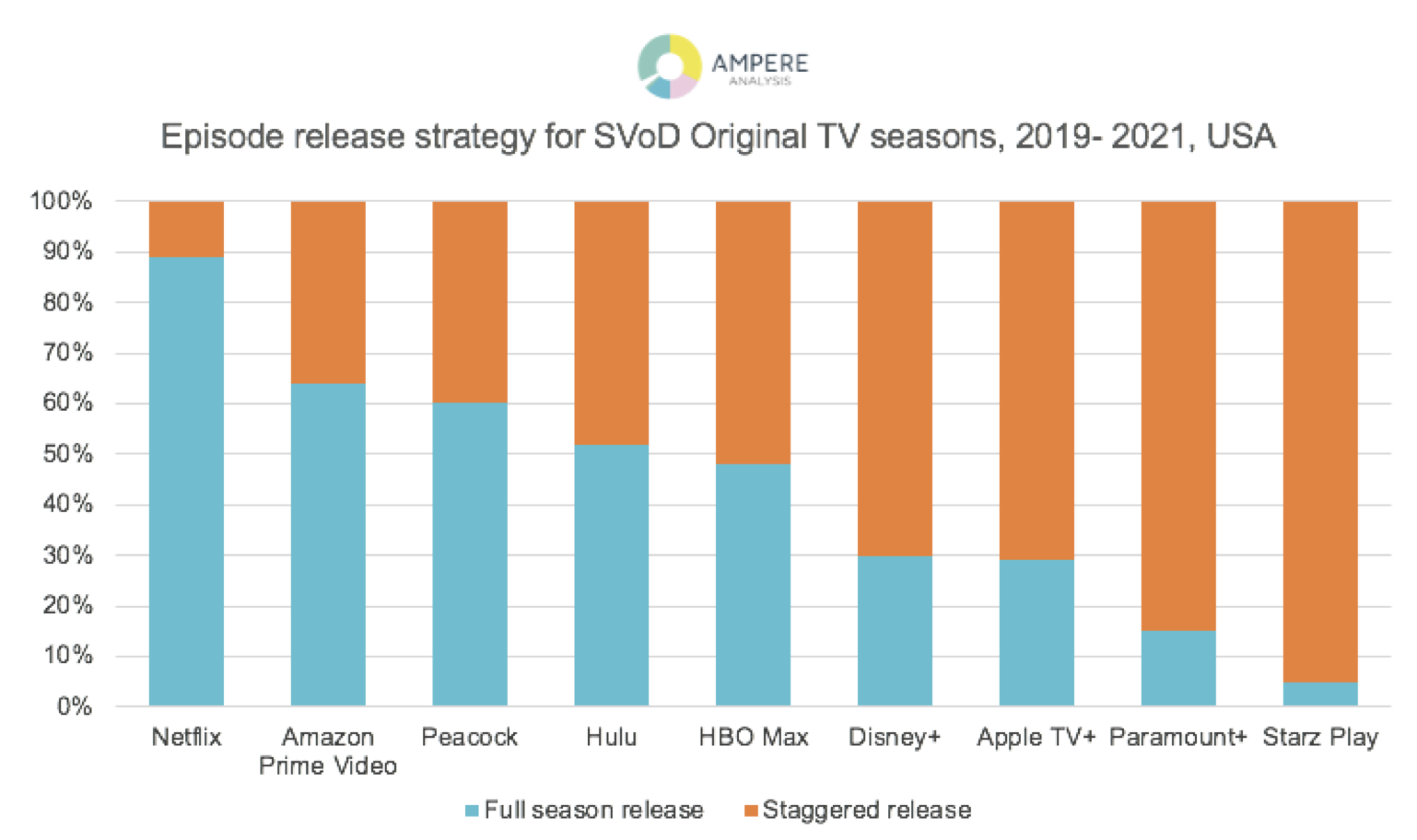
Stranger Things is without doubt the best example of event television since Game of Thrones. So, three years after events in Westeros came to a dismal climax, what do those in Hawkins, Indiana tell us about the state of television?
First off, there will be spoilers below. We’ll try to keep them to a minimum, but if you haven’t watched the whole of Season 4 of the Duffer Brothers’ Netflix leviathan, Stranger Things, some things may very well leak around the edges - it’s that sort of show.
But then, it’s that sort of cultural phenomenon. It has united what has become a famously fragmented television audience into single whole, working across generations and across technologies. So, what does its success tell us about the state of television in 2022? Well, first…
- Water cooler TV is still very possible
It has long been tempting to assume that audiences are too fragmented nowadays to create that enormous surge of interest where it appears that everyone, everywhere is talking about the same thing. Netflix has something like 220 million subscribers worldwide, but given that the all-time record audience for a non-sporting event in the US alone is just over 100 million (the 1983 finale of M*A*S*H*, since you ask), it is obviously a comparatively limited audience. Even if you figure in password sharing and illegal streaming, a streaming service cannot reach anything like the numbers that traditional TV services can.
But then, Game of Thrones did and that was theoretically a Pay-TV only experience (in practise it was the most pirated TV show each year of its run). If anything, though, Stranger Things has done even better. From providing the soundtrack to the summer in the shape of Kate Bush’s 35 year old masterpiece ‘Running up that Hill’, to temporarily crashing Netflix’s servers when Volume 2 released at 3am EST on 1 July, Stranger Things has woven itself quite spectacularly into the cultural zeitgeist. And it’s managed to do that effectively over the course of two long weekends. Thrones kept itself to traditional weekly release schedules, while Things has maintained the binge drop that Netflix has pioneered. Which leads us to point 2.
2. It’s Netflix 1 : Disney+ 0
Figures for Vol 2 are yet to come out, but when it comes to Vol 1 we know that 287 million viewing hours were logged in the three days after the show was added to the platform. That comfortably overtakes Bridgerton Season 2’s 193 million hours debut weekend, making it the biggest opening weekend ever for an English-language series on Netflix. It also reached the number one spot in Netflix’s Top 10 rankings in 83 of 93 countries (it made the Top 10 in the remaining ten).
Where it gets interesting is when US audience specialist Nielsen had a peak into the numbers and started comparing the opening weekend of Stranger Things to that of Disney+’s Obi-Wan Kenobi.
More people (6.2 million) watched the first episode of Obi-Wan Kenobi than the first episode of Stranger Things (6.0 million) on the first day of US release. However, it’s a long game nowadays, and, by the end of the premiere weekend, Stranger Things Episode 1 had attracted 12.7 million viewers up against Obi-Wan Episode 1’s 11.2 million viewers.
However, we’re in a new television universe nowadays, and Nielsen also looked at minutes viewed. Here, the difference in episode duration (Obi-Wan Kenobi Season 1, Episode 1 was a fairly typical broadcast 53 minutes vs. a hefty 76 minutes for Stranger Things Season 4, Episode 1) had a huge impact on the figures, helping Stranger Things open up a decent lead with 967 million minutes viewed vs 592 million.
Why does this matter? Because both services are going to launch ad-driven versions in the next few months, reasoning that am ad-supported lower monthly cost will allow them to ride the coming recession and still keep expanding. More viewed minutes means more chances to serve up ads, and that means in turn that longer episodes may well become the norm rather than the exception.
3. We need more figures
Just as an aside, the big streamers that are moving into AVOD (Advertising Video on Demand) are going to have to change their attitude when it comes to disclosing viewing figures. As you can tell from the above, they rather drip feed information, letting third parties do the heavy lifting. Advertisers are going to demand a lot more transparency in the process, which should give the rest of us a window into what works and what doesn’t and exactlyy how many people are watching
4. The binge drop still works — sometimes
Talking of which, Netflix has stubbornly kept to the binge drop for ST4, splitting the season in two to have two bites of the cherry in its core US market over Memorial Day and Independence Day weekends. In some ways it was lucky; the huge global success of ‘Running up That Hill’ managed to keep the show in the dead centre of the media stream in the gap between so that effectively there was no lull.
But, all the same, that only gave the show a mere five and a bit weeks in the sun. If it had gone for a weekly drop (and chopped that over-stuffed ninth episode in two) it would have been part of the cultural conversation through until August.
This is what all the other most watched shows of 2022 have done. Severance, Moon Knight et al have all been released via weekly drops, and Ampere Analysis did some interesting research on the direction of travel on all this.
The chart below shows its findings for 2019-2021. While that means it misses the fact that, for instance, Amazon has largely abandoned the binge release (and who can blame them, with $450m of Tolkien coming up in September), it does show how much of an outlier Netflix has now become.
 Ampere reckons that a weekly release strategy across a range of high-profile original show keeps viewers on side. Disney+, for example, released episodes of new MCU TV shows across 34 weeks in 2021. Any devoted fan of Marvel content - and they do tend to the devoted - wishing for a spoiler-free life would have to subscribe to Disney+ for well over half the year to watch each episode as soon as possible.
Ampere reckons that a weekly release strategy across a range of high-profile original show keeps viewers on side. Disney+, for example, released episodes of new MCU TV shows across 34 weeks in 2021. Any devoted fan of Marvel content - and they do tend to the devoted - wishing for a spoiler-free life would have to subscribe to Disney+ for well over half the year to watch each episode as soon as possible.
The analyst also runs what it calls a popularity score metric based on online searches and social noise, and this also shows that engagement falls off a cliff with whole season drops. With a weekly drop, initial buzz faded down to 80% over a four month period; with a binge drop that was all over and done in about a month.
No surprise then that currently popular with Apple and Amazon in particular is the semi-binge: an initial drop of two or three episodes followed by a weekly release. This unites the initial explosion of interest with what the broadcaster can hope is a sustained conversation afterwards — and one that may usefully extend over into a subscription renewal.
So, what do we know about Stranger Things Series 5?
Netflix is, of course, not in the same peak of health it was when Stranger Things 4 started filming. It’s lost subscribers, when the figures come in for Q2 2022 it’s likely to have lost even more, and it needs its tentpole shows such as Stranger Things to really work for it.
Season 5 will be bigger, certainly (better is a value judgement that we’ll leave to others). The budget has expanded massively as the show has gone on, and when fissures ripped through Hawkins at the end of the last episode you realised that we were moving into whole new vfx territory.
A July 4 episode of the Happy Sad Confused podcast with the Duffer Brothers saw them commit to another movie-length final episode (with, slightly dismayingly, “like, eight endings”) but it looks like the rest of the episodes will be more around the typical hour length. The real question is whether Netflix will still drop them all at once or if, by then, the industry might have changed enough that it feels that a weekly drop and the chance to get its massive audience analysing each plot twist in forensic detail between episodes will keep its audience onboard and engaged for that little bit longer.
Either way we must hope that it doesn’t drop the ball and, do what in industry parlance, has become known as ‘a Thrones’. Eleven summoning a massive dragon and laying waste to all of Hawkins before eventually being stabbed to death by Mike? You read it here first…
Tags: Production Editor Featured


Comments